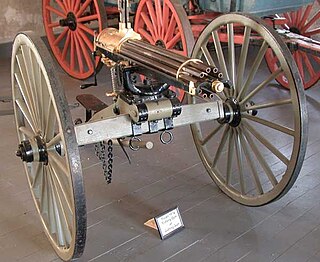
The M61 Vulcan is a hydraulically, electrically or pneumatically driven, six-barrel, air-cooled, electrically fired Gatling-style rotary cannon which fires 20 mm rounds at an extremely high rate. The M61 and its derivatives have been the principal cannon armament of United States military fixed-wing aircraft for fifty years.

The Phalanx CIWS is a close-in weapon system for defense against anti-ship missiles, helicopters, etc. It was designed and manufactured by the General Dynamics Corporation, Pomona Division. Consisting of a radar-guided 20 mm Vulcan cannon mounted on a swiveling base, the Phalanx has been used by multiple navies around the world, notably the U.S. Navy on every class of surface combat ship with the exception of the San Antonio-class LPD, by the Canadian Royal Canadian Navy, the British Royal Navy, and by the U.S. Coast Guard aboard its Hamilton and Legend-class cutters. The Phalanx is used by 15 other allied nations.

Goalkeeper is a Dutch close-in weapon system (CIWS) introduced in 1979. It is an autonomous and completely automatic weapon system for short-range defence of ships against highly maneuverable missiles, aircraft and fast maneuvering surface vessels. Once activated the system automatically undertakes the entire air defense process from surveillance and detection to destruction, including selection of the next priority target.
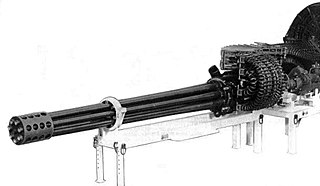
The General Electric GAU-8/A Avenger is a 30 mm hydraulically driven seven-barrel Gatling-style autocannon that is typically mounted in the United States Air Force's Fairchild Republic A-10 Thunderbolt II. Designed specifically for the anti-tank role, the Avenger delivers very powerful rounds at a high rate of fire. The GAU-8/A is also used in the Goalkeeper CIWS ship weapon system, which provides defense against short-range threats such as highly maneuverable missiles, aircraft, and fast maneuvering surface vessels.
The General Dynamics GAU-12/U Equalizer is a five-barrel 25 mm Gatling-type rotary cannon. The GAU-12/U is used by the United States, Italy and Spain, which mount the weapon in their fighter jets such as the AV-8B Harrier II, airborne gunships such as the Lockheed AC-130, and land-based fighting vehicles. A lighter four-barrel version, designated GAU-22/A, is mounted on F-35 Lightning II fighter jets.

AK-230 is a Soviet fully automatic naval twin 30 mm gun. Its primary function is anti-aircraft. It is mounted in an enclosed automatic turret and directed by radar. AK-230 is widely used, mounted on big warships as well as small crafts. About 1450 guns were produced in the USSR, and about 300 were produced in China as the Type 69. It was succeeded by the more powerful AK-630 from the mid-to-late 1970s.

A revolver cannon is a type of autocannon, commonly used as an aircraft gun. It uses a cylinder with multiple chambers, like those of a revolver handgun, to speed up the loading-firing-ejection cycle. Some examples are also power-driven, to further speed the loading process. Unlike a rotary cannon, a revolver cannon has only a single barrel, thus its spun weight is lower. Automatic revolver cannon have been produced by many different manufacturers.
The M134 Minigun is a 7.62×51mm NATO six-barrel rotary machine gun with a high, sustained rate of fire. It features a Gatling-style rotating barrel assembly with an external power source, normally an electric motor. The "Mini" in the name is in comparison to larger-caliber designs that use a rotary barrel design, such as General Electric's earlier 20 mm M61 Vulcan, and "gun" for the use of rifle caliber bullets as opposed to autocannon shells.
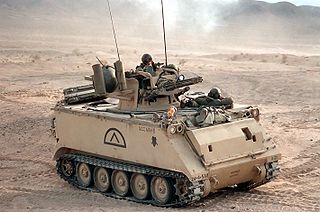
The M163 Vulcan Air Defense System (VADS) is a self-propelled anti-aircraft gun (SPAAG) that was used by the United States Army. The M168 gun is a variant of the General Dynamics 20 mm M61 Vulcan rotary cannon, the standard cannon in most U.S. combat aircraft since the 1960s, mounted on either an armored vehicle or a trailer.

The M242 Bushmaster is a 25 mm (25×137 mm) chain-driven autocannon. It is used extensively by the U.S. military, as well as by NATO's and some other nations' forces in ground combat vehicles, such as the Bradley fighting vehicle and various watercraft. Originally the weapon was designed and manufactured by Hughes Ordnance in Culver City, California, which was acquired by McDonnell Douglas ; however it is now produced by Northrop Grumman Innovation Systems.

A rotary cannon, rotary autocannon, or Gatling-type cannon is a rapid-firing weapon that utilizes multiple barrels in a rotating cluster to provide a sustained rate of fire and saturation greater than single-barreled machine guns or autocannons of equivalent caliber. The loading, firing, and unloading functions are performed simultaneously in different barrels as they rotate, and the rotation also permits the barrels some time to cool. The rotating barrel cluster on most Gatling-type guns is powered by an external force such as an electric motor, although gas-operated versions have also been developed.

INS Trishul (F43) is the second frigate of the Talwar class of the Indian Navy. Trishul, the guided missile frigate, joined the arsenal of Indian Navy in 2003. The ship was commissioned by the then Flag Officer Commanding-in-Chief, Western Naval Command Vice Admiral Arun Prakash at St. Petersburg, Russia on 25 June 2003. It has a complement of 32 officers and 228 sailors. In contrast to the lead ship INS Talwar, the sea trials of Trishul were considerably shortened as the ship performed well. Trishul arrived in Mumbai on 23 September 2003.

The AK-630 is a Soviet and Russian fully automatic naval close-in weapon system based on a six-barreled 30 mm rotary cannon. In "630", "6" means 6 barrels and "30" means 30 mm. It is mounted in an enclosed automatic turret and directed by MR-123 radar and television detection and tracking. The system's primary purpose is defense against anti-ship missiles and other precision guided weapons. However it can also be employed against fixed or rotary wing aircraft, ships and other small craft, coastal targets, and floating mines. Once operational, this weapon system was rapidly adopted, with up to 8 units installed in every new Soviet warship, and hundreds produced in total.
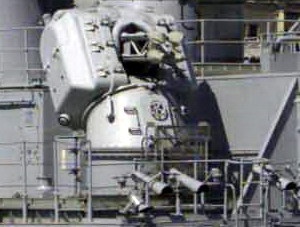
Sea Zenith is a four-barrelled 25 mm CIWS used by the Turkish Navy on their MEKO 200 frigates, like the Barbaros and Yavuz classes. It was developed in the 1980s by Oerlikon Contraves around their Oerlikon KBB gun and manufactured in Switzerland. This automatic gun uses a 25x184mm cartridge at a rate of 800 rounds a minute. Using four independent guns instead of one multi-barrelled rotary cannon improves reliability. The system is mounted in an enclosed automatic turret and directed by the Seaguard radar developed by Contraves. The turret is tilted back to allow a higher elevation to intercept diving missiles. The system's primary purpose is defence against anti-ship missiles, and other precision guided weapons. However it can also be employed against fixed/rotary wing aircraft, ships and other small craft, coastal targets, and floating mines.

The Type 730 is a Chinese seven-barrelled 30 mm Gatling gun CIWS. It has a PLA-N designation H/PJ12. It is mounted in an enclosed automatic turret and directed by radar, and electro-optical tracking systems. The maximum rate of fire is 5800 rd/m, and the effective range is up to 3 km.
Type 348 radar is a Chinese fire control radar developed for Type 76 twin 37 mm naval gun as CIWS, and it incorporates features of Italian RTN-10X and RTN-20X sold to China in 1992. Type 348 radar is frequently but erroneously confused and misidentified as another Chinese naval radar Type 346 due to the lack of publicized information in the development of the latter.
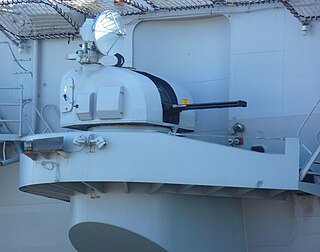
The Meroka CIWS is a Spanish Navy 12 barrelled 20 mm CIWS, using twelve Oerlikon 20 mm/120 guns mounted in 2 rows of 6 guns each. The system's primary purpose is defence against anti-ship missiles, and other precision guided weapons. However it can also be employed against aircraft, ships and other small craft, coastal targets, and floating mines. The weapon is mounted primarily on Spanish naval vessels, from frigate size upwards.

The Royal Ordnance L11A5 is a 120 mm L/55 rifled tank gun design. It was the first of NATO's 120mm Main Battle Tank guns which became the standard calibre for Western tanks in the later period of the Cold War. By 2005, a total of 3,012 L11 guns were produced. List price was US $227,000 (1990).

A multiple barrel firearm is a firearm of any type with more than one barrel, usually to increase the rate of fire/hitting probability and to reduce barrel erosion/overheating.

